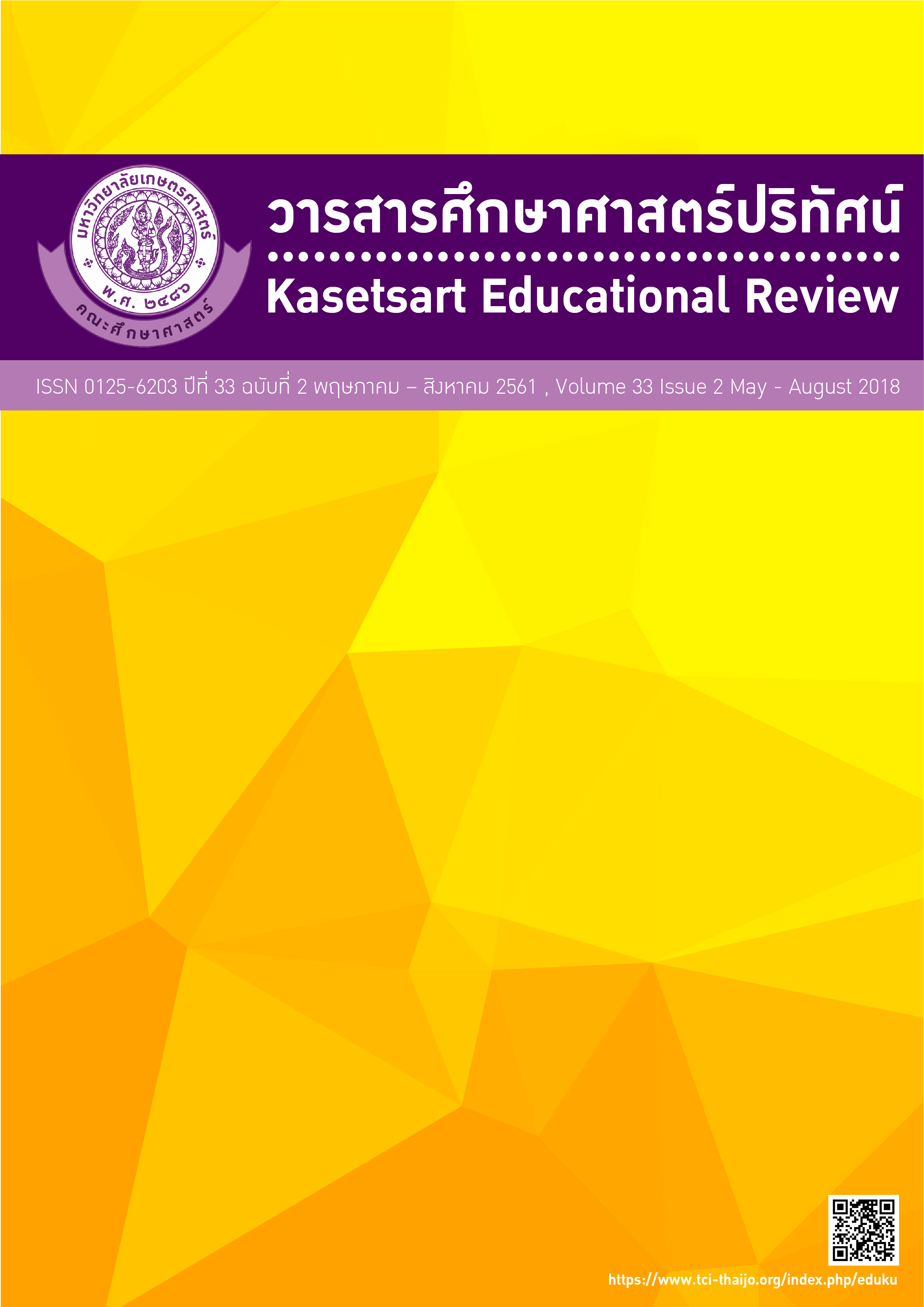การเรียนการสอนเคมีโดยใช้แนวคิด 3 ระดับ
คำสำคัญ:
การเรียนการสอนเคมี, แนวคิด 3 ระดับ, ระดับการสังเกต, ระดับอนุภาค, ระดับสัญลักษณ์บทคัดย่อ
บทความนี้มีวัตถุประสงค์เพื่อนำเสนอแนวทางการจัดการเรียนการสอนเคมี โดยใช้แนวคิด 3 ระดับ จากผลการวิจัยที่ผ่านมาแสดงให้เห็นว่า การเรียนการสอนเคมีโดยใช้แนวคิด 3 ระดับ ซึ่งประกอบด้วย ระดับการสังเกต ระดับโมเลกุล และระดับสัญลักษณ์ ส่งผลให้ผู้เรียนเกิดการเรียนรู้อย่างมีความหมายและเข้าใจเนื้อหาอย่างลึกซึ้ง ถึงแม้ว่าประเทศไทยได้มีการนำแนวคิด 3 ระดับ มาใช้ในการเรียนการสอนเคมีบ้างแล้ว แต่งานวิจัยในเรื่องดังกล่าวยังมีอยู่จำกัด อีกทั้งแหล่งเรียนรู้ ที่เกี่ยวกับแนวคิด 3 ระดับ ที่เป็นหนังสือ บทความวิจัยและบทความวิชาการยังไม่แพร่หลายมากนัก ผู้เขียนเห็นว่าการนำแนวคิดดังกล่าวมาใช้ในการเรียนการสอน มีความสำคัญและมีประโยชน์ต่อการจัดการเรียนการสอนเคมี จึงได้เขียนบทความวิชาการฉบับนี้ขึ้น โดยผลที่คาดว่าจะได้รับจากบทความนี้คือ น่าจะเป็นประโยชน์ต่อครูผู้สอนวิชาเคมี ครูผู้สอนวิชาวิทยาศาสตร์ ผู้จัดทำหลักสูตร นักวิชาการ นักวิจัยและผู้ที่สนใจได้นำไปศึกษาและประยุกต์ใช้ในการจัดการเรียนการสอนต่อไป โดยหัวข้อที่ใช้ในการเขียนบทความ เรียงลำดับดังนี้ 1) ความยากและความเข้าใจที่คลาดเคลื่อนในวิชาเคมี 2) หลักสูตรเคมี (ฉบับปรับปรุง 2560) 3) แนวคิด 3 ระดับกับการจัดการเรียนการสอน โดยบทความฉบับนี้ได้มุ่งเน้นไปที่เรื่องความยากและความเข้าใจที่คลาดเคลื่อนในวิชาเคมี และเรื่องแนวคิด 3 ระดับ ที่บอกถึงที่มา ความหมาย ความสำคัญ ตัวอย่างการจัดการเรียนการสอน ข้อดี ข้อจำกัด รวมทั้งการเตรียมผู้เรียนและผู้สอนสำหรับการเรียนการสอนโดยใช้แนวคิด 3 ระดับ
เอกสารอ้างอิง
Boz, Y. (2006). Turkish Pupils’ Conceptions of the Particulate Nature of Matter. Journal of Science Education and Technology, 15(2), 203-213.
Bucat, B. (2004). Pedagogical content knowledge as a way forward: Applied research in chemistry education. Chemistry education research and practice, 5, 215–228.
Bunce, D.M., & Gabel, D. (2002). Differential effects on the achievement of males and females of teaching the particulate nature of chemistry. Journal of Research in Science Teaching, 39(10), 911-927.
Chandrasegaran A. L., & Treagust D. F. (2008). An Evaluation of a Teaching Intervention to Promote Students’ Ability to Use Multiple Levels of Representation When Describing and Explaining Chemical Reaction. Research in Science Education. 38, 237-248.
Chandrasegaran, A. L., Treagust, D. F., Waldrip, B. & Chandrasegaran. A. (2009). Students’ dilemmas in Reaction Stoichiometry Problem Solving: Deducing the Limiting Reagent in Chemical Reactions. Chemistry Education Research and Practice, 10, 14-23.
Chang, H.P., & Lederman, N. G. (1994). The Effect of Levels of Cooperative within Physical Science Laboratory Groups on Physical Science Achievement. Journal of Research in Science Teaching, 31(2), 167-181.
Chittleborough, G. D., Treagust, D.F., & Mocerino, M. (2002). Constraints to the development of first year university chemistry students’ mental models of chemical phenomena. Proceedings of the 11th Annual Teaching Learning Forum. Perth, Australia.
Devetak, I., Vogrine, J., & Glazar, S.A. (2009). Assessing 16 year-old students’ understanding of aqueous solution at sub-microscopic level. Research in Science Education, 39(2), 157-159.
Dickson, H., Thomson, C., & O’Toole, P. (2016). A Picture is Worth a Thousand Words: Investigating First Year Chemistry Students’ Ability to Visually Express Their Understanding of Chemistry Concepts. International Journal of Innovation in Science and Mathematics Education, 24(1), 12-23.
Freedman, P. M. (1997). Relationship among Laboratory Instruction, Attitude toward Science, and Achievement in Science Knowledge. Journal of Research in Science Teaching, 34(4), 347-357.
Gabel, D. L. (1994). Handbook of research on science teaching and learning. New York: MacMillan.
Gabel, D. L. (1999). Improving teaching and learning through chemistry education research: A look to the future. Journal of Chemical Education, 76 (4), 548-554.
Gunstone, R. F., & Champagne, A. B. (1990). Promoting conceptual change in the laboratory. In E. Hegarty-Hazel(Ed.), The student laboratory and the science curriculum, pp.159-182. London: Routlegde.
Johnstone, A. H. (1991). Why is science difficult to learn? Things are seldom what they seem. Journal of Computer Assisted Learning, 7, 75-83.
Johnstone, A. H. (2000). Teaching of chemistry: Logical or psychological? Chemical Education: Research and Practice in Europe, 1(1), 9-15.
Johnstone. A. H., & Selepeng, D. (2001). A Language Problem Revisited. Chemistry education: Research and Practice in Europe, 2(1), 19-29.
Kelly, R. M., & Hansen, S. (2017). Exploring the design and use of molecular animations that conflict for understanding chemical reactions. Quimica Nova, 40(4), 476-481.
Kelly, R. M., Barrera, J. H., & Mohamed, S. C. (2010). An Analysis of Undergraduate General Chemistry Students’ Explanations of the Submicroscopic Level of Precipitation Reactions. Journal of Chemical Education 87(1), 113-118.
Marais, P., & Jordaan, F. (2000). Are we walking symbolic language for granted? Journal of Chemical Education, 77(10), 1355-1357.
Naah, B., & Sanger. M. (2012). Student Misconceptions in Writing Balance Equations for Dissolving Ionic Compounds in Water. Chemistry Education Research and Practice, 13, 186-194.
Skryabina, E. (2000). Student Attitude to Learning Physics at School and University Levels in Scotland, PhD Thesis, University of Glassgow.
Sweller, J. (2004). Instructional design consequences of an analogy between evolution by natural selection and human cognitive architecture. Instructional Science, 32, 9–31.
Tasker, R., & Dalton, R. (2008). Visualising the molecular world- design, evaluation, and use of animations. In Gilbert J., Reiner, M., & Nakhleh, M. (Eds.). Visualisation: Theory and Practice in Science Education. Springer, Dordrecht, pp.103-131.
Treagust, D. F., Chandrasegaran, A. L., Zain, A. N., Ong, E. T., Karpudewan, M., & Halim, L. (2011). Evaluation of an intervention instructional program to facilitate understanding of basic particle concepts among students enrolled in several levels of study, Chemistry education research and practice, 12, 251–261.
Treagust, D.F., Chittleborough, G., & Mamiala, T.L. (2003). The role of submicroscopic and symbolic representations in chemical explanations. International Journal of Science Education, 25(11), 1353-1368.
Tucky, H., & Selvaratnam, M. (1993). Studies involving three-dimentional visualization skills in chemistry. Studies in Science Education, 21, 99-121.
Zhang, Z., & Linn, M. (2011). Can Generating Representations Enhance Learning with Dynamic Visualizations? Journal of Research in Science Teaching, 48(10), 1177–1198.
ดาวน์โหลด
เผยแพร่แล้ว
ฉบับ
ประเภทบทความ
สัญญาอนุญาต
บทความทุกบทความเป็นลิขสิทธิ์ของวารสารคณะศึกษาศาสตร์ มหาวิทยาลัยเกษตรศาสตร์ วิทยาเขตบางเขน
วารสารศึกษาศาสตร์ปริทัศน์ (Kasetsart Educational Review)






